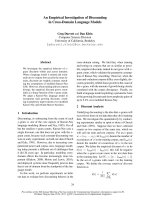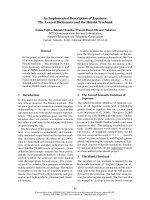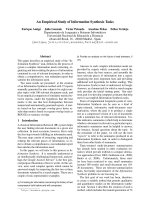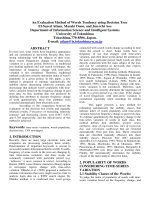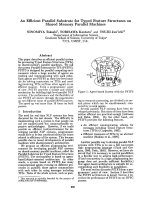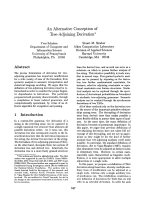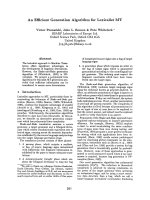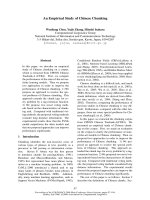Báo cáo khoa học: "An efficient micro-method of DNA isolation from mature leaves of four hardwood tree species Acer, Fraxinus, Prunus and Quercus" pdf
Bạn đang xem bản rút gọn của tài liệu. Xem và tải ngay bản đầy đủ của tài liệu tại đây (523.23 KB, 5 trang )
Note
An
efficient
micro-method
of
DNA
isolation
from
mature
leaves
of
four
hardwood
tree
species
Acer,
Fraxinus,
Prunus
and
Quercus
François
Lefort*
Gerard.
C.
Douglas
a
a
Teagasc,
Food
and
Agriculture
Development
Authority,
Kinsealy
Research
Centre,
Malahide
Road,
Dublin
17,
Ireland
b
Laboratory
of Plant
Physiology
and
Biotechnology,
Department
of
Biology,
University
of
Crete,
P.O.
Box
208,
71409
Heraklio,
Greece
(Received
5
January
1998;
accepted
1 October
1998)
Abstract -
It
is
difficult
to
purify
DNA
from
mature
tree
leaves
at
the
end
of
the
growing
season,
because
of
their
thick
cell
wall,
and
high
content
in
polysaccharides,
phenolic
compounds
and
endonucleases.
A
simple,
fast
and
efficient
method
for
DNA
purification
from
100
mg
fresh
weight
leaf
samples
is
described
here.
It
has
been
developed
for
extracting
DNA
from
mature
leaves
of
Quercus,
Fraxinus
Prunus
and
Acer.
The
protocol
is
a
modified
CTAB
(hexadecyltrimethylammonium
bromide)
method
including
a
combina-
tion
of
β-mercaptoethanol,
polyvinylpyrrolidone,
sodium
dodecyl
sulfate
and
lithium chloride
including
short
centrifugation
runs.
It
is
very
efficient
yielding
up
to
950
μg
DNA/g
of
fresh
weight,
even
when
very
mature
leaves
are
processed.
The
extracted
DNA
was
used
as
template
to
characterise
oaks
by
microsatellite
analysis.
Its
efficiency
has
been
compared
to
four
commercially
available
kits
and
two
other
published.
CTAB
protocols.
The
protocol
is
also
inexpensive
compared
to
commercial
kits.
(©
Inra/Elsevier,
Paris.)
Acer
/
DNA
purification
/
Fraxinus
/
Prunus
/
Quercus
Résumé -
Une
micro-méthode
d’extraction
d’ADN
à
partir
de
feuilles
matures
de
quatre
espèces
d’arbres
forestiers
Acer,
Fraxinus,
Prunus
et
Quercus.
Il
est
difficile
de
purifier
l’ADN
de
feuilles
d’arbres
à
maturité
et
spécialement
à
la
fin
de
la
période
de
croissance
c’est-à-dire
en
automne,
pour
plusieurs
raisons,
telles
que
de
fortes
concentrations
de
polysaccharides,
de
composés
phénoliques
et
d’endonucléases
ainsi
que
des
parois
cellulaires
épaisses.
Nous
décrivons
une
micro-méthode
efficace
et
rapide
per-
mettant
de
purifier
de
l’ADN
à
partir
de
100
mg
de
poids
frais
de
feuilles
à
maturité
des
espèces
d’arbres
suivantes :
Quercus
robur,
Q.
petraea,
Fraxinus
excelsior,
Prunus
avium
et
Acer
pseudoplatanus.
Le
protocole
est
basé
sur
l’utilisation
de
bromure
d’hexadé-
cyltriméthylammonium
(CTAB)
combiné
a
l’emploi
de
β-mercaptoéthanol,
de
polyvinylpyrrolidone,
de
sodium
dodécyl
sulfate
et
de
chlorure
de
lithium.
Cette
micro-méthode
permet
d’obtenir
jusqu’à
950
μg
DNA
/
g
de
poids
frais.
L’ADN,
extrait
d’une
variété
de
matériels
végétaux
(culture
in
vitro,
matériel
de
serre
ou
prélevés
en
forêt)
par
cette
méthode,
est
de
la
qualité
nécessaire
aux
tech-
niques
de
biologie
moléculaire
(digestion
enzymatique,
clonage
ou
amplification
par
la
réaction
de
la
polymérase
en
chaîne
(PCR)
de
marqueurs
microsatellites).
Son
efficacité
comparée
à
celle
de
quatre
protocoles
commercialisés
et
deux
autres
protocoles
basés
sur
l’emploi
de
CTAB
est
supérieure
en
rendement
et
qualité.
Ce
protocole
a
enfin
l’avantage
d’être
bon
marché
par
rapport
aux
pro-
tocles
commerciaux.
(©
Inra/Elsevier,
Paris.)
Acer
/
ADN
/
Fraxinus
/
Prunus
/
Quercus
*
Correspondence
and
reprints
1.
INTRODUCTION
Plant
breeding
and
genetic
identification
have
until
recently
relied
only
on
phenotype
analysis
(either
by
direct
phenotype
assessment,
or
by
analysis
of
varied
isoenzymes
systems).
Because
phenotypic
traits
are
affected
by
many
factors,
it
can
be
a
valuable
method
to
assess
polymorphic
variation.
The
appearance
of
molec-
ular
genetic
techniques
such
RFLP
(restriction
fragment
length
polymorphism)
and
then
RAPD
(random
ampli-
fied
polymorphic
DNA)-PCR
offers
a
direct
access
to
the
DNA
level.
Furthermore,
microsatellites
sequences
are
becoming
available
for
an
increasing
number
of
plant
and
tree
species.
Microsatellite
PCR
offers
a
reliable
method
to
assess
DNA
polymorphism
of
numerous
indi-
viduals
within
a
species
and
among
species
of
a
same
genus.
However,
all
these
molecular
techniques
require
the
availability
of
DNA
in
sufficient
quantity
and
of
good
quality
and
purity.
Although
several
different
extraction
methods
have
been
published
for
herbaceous
plants
and
trees
[1-
4,
8,
11-13]
and
are
even
available
as
commercial
kits,
proto-
cols
are
either
too
long,
involve
excessive
volumes
of
extraction
buffer,
are
only
efficient
for
a
range
of
species
or
for
one
type
of
plant
material.
Last
but
not
least,
most
of
the
protocols
are
simply
not
efficient
for
difficult
material.
Many
protocols
may
provide
DNA
when
pro-
cessing
in
vitro
material
or
young
leaves
of
herbaceous
plants
and
trees;
however,
they
may
be
unsuitable
for
extracting
DNA
from
mature
or
dry
leaves.
DNA
finger-
printing
means
that
a
great
number
of
samples
have
to
be
processed,
thus
the
DNA
purification
protocol
must
be
fast
and
easy
to
standardise
in
order
to
extract
numerous
samples
in
a
workday.
After
having
tested
a
number
of
commercial
kits
and
published
methods
for
DNA
extraction
on
the
different
trees
we
are
working
with,
we
developed
a
protocol
to
extract
DNA
from
mature
leaves
harvested
in
October,
from
four
hardwood
tree
species:
Quercus,
Fraxinus,
Prunus
and
Acer.
2.
MATERIAL
AND
METHODS
2.1.
Plant
material
Fresh
mature
leaves
were
collected
in
October
from
grafted
elite
clones
of
Quercus
robur,
Q.
petraea,
Fraxinus
excelsior,
Prunus
avium
and
Acer
pseudopla-
tanus.
Plants
were
grown
in
the
glasshouse,
outdoors
(field,
arboretum)
and
in
some
cases
leaves
from
in
vitro
stocks
were
also
used.
2.2.
DNA
purification
One
hundred
milligrams
of
fresh
plant
material
(leaf)
was
ground
in
liquid
nitrogen
using
a
ceramic
mortar
and
pestle
to
give
a
green
powder.
The
powder
was
transferred
to
a
new
1.5
mL
polypropylene
tube
using
a
spatula.
At
this
time,
1
mL
of
DNA
extraction
buffer
[50
mM
Tris-HCl
pH
8.0,
20
mM
EDTA
pH
8.0,
0.7
M
NaCl,
0.4
M
LiCl,
1
%
w/v
CTAB
(hexadecyltrimethy-
lammonium
bromide),
1
%
w/v
PVP
40,
2
%
w/v
SDS]
and
10
μL
of
β-mercaptoethanol
(1
%
final
concentra-
tion)
were
added.
The
mixture
was
vortexed
for
5
s,
mixed
by
2-3
inversion
and
then
incubated
for
15
min
at
65 °C
in
a
water-bath.
After
addition
of
the
powdered
leaf
material
and
immersion
in
the
65
°C
water
bath,
the
mixture
became
clear
in
a
few
seconds,
as
soon
as
the
different
reagents
interacted
with
proteins,
phenolic
compounds
and
poly-
saccharides.
After
incubation,
0.5
mL
of
chloroform/isoamylalco-
hol
(24:1)
was
added
to
the
tube,
the
mixture
was
agitat-
ed
thoroughly
until
making
an
emulsion
and
centrifuged
1-5
min
in
a
microfuge
at
17 000
g (14 000
rpm
in
an
ALC
microcentrifugette
4214
rotor
A-12).
The
aqueous
phase
was
transferred
to
a
new
1.5
mL
tube
and
cen-
trifuged
1
min
at
17
000
g in
order
to
pellet
possible
debris.
The
supernatant
was
then
transferred
to
a
new
tube
and
an
equivalent
volume
of
isopropanol
was
added
to
the
aqueous
solution.
The
tube
was
swirled
gently
and
a
white
DNA
precipitate
appeared.
The
tube
was
then
centrifuged
1
min
at
17
000 g
and
the
supernatant
was
withdrawn.
The
DNA
pellet
was
washed
with
1
mL
70
%
ethanol,
centrifuged
for
1
min
at
17
000
g.
Finally
the
supernatant
was
withdrawn
and
the
pellets
allowed
to
dry
on
the
bench
for
10
min.
DNA
pellets
were
resus-
pended
in
50-100
μL
of
10
mM
Tris-HCl
pH
8.0,
1
mM
EDTA.
As
the
solution
contained
RNA
and
DNA,
the
protocol
was
followed
by
a
RNase
digestion
to
remove
RNAs.
RNA
digestion
was
performed
by
adding
2
μL
of
RNase
(0.5
mg
mL-1
)
(Boehringer
Mannheim,
UK)
and
incubating
for
30
min
at
37
°C.
Although
the
resulting
DNA
mixture
could
be
directly
used
after
RNase
digestion
in
amplification
experiments,
it
also
could
be
ultimately
purified
through
a
column
such
as
the
Wizard
Clean-up
System
(Promega
Biotec,
Madison,
WI,
USA).
While
developing
this
protocol
we
also tested
four
commercial
kits
(DNA
Isolator,
Genosys,
UK;
Nucleon
Phytopure,
Scotlab,
UK;
Snap-O-Sol
Biotexc,
USA
and
Xtract,
AMS
Biotechnologies,
USA)
and
two
modified
CTAB
protocols
[4,
13].
The
Nucleon
Phytopure
kit
and
the
two
published
protocols
were
specifically
designed
for
plant
material.
2.3.
DNA
analysis
DNA
concentration
was
given
by
absorbance
reading
at
260
nm
and
280
nm
in
a
UV
spectrophotometer.
Purity
was
estimated
by
the
OD260/OD280
ratio.
DNA
quantities
were
also
confirmed
by
estimation
after
ethidi-
um
bromide
staining
viewed
under
UV
light
on
1
%
agarose
gels
gel
in
1X
Tris
Borate
EDTA
(TBE)
buffer.
Samples
were
run
along
with
four
known
quantities
(0.1,
0.25,
0.5
and
1
μg)
of
uncut λ
DNA
(Promega,
USA).
DNA
quality
was
also
estimated
on
the
same
gels.
2.4.
DNA
digestion
DNA
was
digested
by
Hind
III
restriction
enzyme
(Stratagene,
Cambridge,
UK)
according
to
the
manufac-
turer’s
recommendations.
2.5.
Microsatellite
PCR
amplification
We
used
flanking
primers
for
the
microsatellite
locus
AG110
(EMBL
accession
X84082)
which
has
been
described
by
Steinkellner
et
al.
[9].
The
reaction
volume
was
50
μL
and
included
20
mM
Tris-Hcl
pH
8.3,
50
mM
KCl,
1.5
mM
MgCl
2,
62.5
μM
dNTPs
each
(Biofinex,
Praroman,
Switzerland),
1
μM
forward
primer
[5’-ggaggcttccttcaacctact],
1
μM
reverse
primer
[5’-gatctcttgtgtgctgtattt],
1,5
unit
AmpliTaq
poly-
merase
(Perkin
Elmer,
Foster
City,
CA,
USA)
and
approximately
50
ng
DNA
template.
A
5
min
initial
denaturation
at
94
°C
was
followed
by
35
cycles
(50
°C
for
1 min,
72 °C
for
30
s,
92
°C
for
1
min)
terminated
by
an
8
min
final
extension
at
72
°C.
PCR
products
were
checked
on
a
1
%
agarose
gel
in
1xTBE
and
then
analysed
on
a
denaturant
sequencing
gel
(CastAway
gel
6
%
polyacrylamide)
run
in
a
CastAway
Sequencing
System
(Statagene,
La
Jolla,
USA).
Gels
were
run
for
2 h
at
1
500
V,
and
then
silver
stained
according
to
a
modified
silver
staining
protocol
[10].
Lengths
in
base
pairs
of
microsatellites
PCR
products
were
estimated
by
running
a
pBR
322
plasmid
digested
by
Hae
III
(Biofinex)
and
a
pUC
plasmid
digested
by
MspI
(Biofinex)
as
base
pair
length
ladders.
3.
RESULTS
AND
DISCUSSION
This
protocol
is
a
modification
of
the
original
CTAB
protocol
of
Doyle
and
Doyle
[2]
and
other
CTAB
meth-
ods
designed
for
extraction
of
DNA
from
plant
material
[1, 3, 4, 7, 8, 12]).
CTAB
(1-2
%)
extraction
buffers
are
often
made
up
in
Tris-HCl
(0.05-0.1
mM)
buffer
in
a
pH
range
8.0-9.5,
containing
EDTA
(5-50
mM),
NaCl
(1.25-1.5
M).
They
also
often
include
polyvinylpyrroli-
done
(PVP
40 000
up
to
360
000)
and
a
variety
of
reduc-
tants
(DTT,
ascorbic
acid,
β-mercaptoethanol).
PVP
and
reductants
are
used
to
avoid
the
formation
of
insoluble
complexes
between
phenolic
substances
and
DNA.
CTAB
is
a
cationic
detergent
which
disrupts
membranes
and
may
also
complex
DNA
when
NaCl
concentration
is
lower
than
0.7
M
It
is
also
sometimes
replaced
by
sodi-
um
dodecyl
sulfate,
also
a
cationic
detergent
which
is
known
to
complex
with
proteins
and
confer
on
them
a
negative
charge.
We
used
here
both
detergents
in
combi-
nation
with
a
decreased
NaCl
concentration
at
the
limit
at
which
CTAB
complexes
with
DNA.
We
initially
used
very
high
concentrations
of
LiCl
in
order
obtain
a
selec-
tive
precipitation
of
RNAs.
These
trials
did
not
achieve
the
expected
results
but
it
was
observed
that
total
nucleic
acid
yields
were
increased.
After
different
trials
we
kept
LiCl
at
a
concentration
of
0.4
M.
The
improvement
in
DNA
yield
could
maybe
be
explained
by
the
electrostatic
interactions
between
the
different
chemicals,
nucleic
acids
and
proteins.
This
combination
of
chemicals
seems
to
prevent
more
effi-
ciently
formation
of
insoluble
complexes
of
DNA
than
the
classical
combination
of
one
detergent,
one
reduc-
tant,
one
salt
offered
by
other
protocols.
We
found
a
final
concentration
of
1
%
β-mercap-
toethanol
to
be
optimal
in
order
to
keep
the
nucleic
acids
in
a
non-oxidative
environment
and
to
denature
endonu-
cleases
activities.
Freezing
leaf
samples
in
liquid
nitro-
gen
facilitated
cell
breakage
by
grinding
since
mature
leaves
of
trees
are
very
tough
and
other
methods
of
homogenisation
that
we
tested
were
less
successful.
Grinding
in
liquid
nitrogen
provides
a
non-oxidative
environment
that
may
avoid
oxidation
of
phenolic
com-
pounds
present
in
older
leaves
during
homogenisation
of
the
tissue.
This
protocol
resulted
in
white
DNA
pellets
easily
solubilised
in
TE
buffer.
Figure
1
shows
DNA
and
Hind
III
digested
DNA
from
mature
leaves
of
each
of
the
four
species.
RNA
was
removed
by
RNase
digestion.
This
protocol
gave
good
quality
DNA
of
a
size
some-
what
above
21
kb.
Another
advantage
of
this
protocol
is
the
small
volume
of
extraction
buffer
enabling
all
steps
to
be
performed
in
a
1.5
mL
Eppendorf
type
tube,
reduc-
ing
useless
handling.
The
time
required
for
a
single
extraction
was
about
40
min
from
the
beginning
to
the
resuspension
in
TE
buffer
and
it
was
easy
to
process
a
large
number
of
sam-
ples
in
a
workday.
The
most
laborious
step
is
the
grind-
ing
step
and
if
numerous
samples
are
extracted,
they
may
be
kept
on
ice
or
in
freezer
(-20
°C)
until
going
on
with
the
65
°C
incubation
step
for
all
samples.
The
grinding
step
could
be
optimised
with
the
use
of
automated
grinders.
This
protocol
might
also
be used
to
obtain
RNA
if
DNase
digestion
is
undertaken.
The
protocol
described
above
was
used
to
extract
DNA
from
20
clones
of
Quercus,
15
clones
of
Fraxinus,
16
clones of
Prunus
and
15
clones
of
Acer.
For
oak,
the
yield
of
DNA
ranged
from 200
to
950
μg
DNA
per
g
fresh
weight
per
clone
and
for
the
three
other
species
the
yields
ranged
from
350
to
950
μg
DNA
per
g
fresh
weight.
OD260/OD280
ratios
were
1.70-1.95.
Comparisons
between
this
modified
CTAB
protocol
and
other
tested
methods
are
given
in
table
I.
Among
the
four
commercial
kits
tested,
only
the
Nucleon
Phytopure
kit
yielded
DNA
but
only
from
in
vitro
culture
and
not
from
other
sources
of
plant
material.
The
method
of
Sul
and
Korban
[12]
was
originally
designed
for
extracting
DNA
from
in
vitro
cultures
of
apple
tree,
Italian
stone
pine,
rose
and
tobacco.
Applied
to
plant
material
of
the
four
species
studied,
it
only
yielded
degraded
DNA
except
for
in
vitro
material.
Only
the
method
of
Graham
et
al.
[3]
yielded
good
quality
DNA
for
all
kind
of
plant
material
but
in
very
poor
amounts.
Microsatellite
polymorphisms
of
17
elite
clones of
oak
obtained
by
amplification
of
the
microsatellite
locus
AG
110
[9]
are
shown
in
figure
2.
As
shown
in
figure
2,
either
a
two-band
profile
was
recorded
when
the
tree
was
heterozygous
at
this
locus,
or
a
one-band
profile
when
the
tree
was
homozygous
at
this
locus.
Unexpectedly
one
tree
Dundrum
91
gave
a
three-band
profile,
where
a
two
band
pattern
was
expected
(figure
2,
arrow).
This
could
be
explained
by
several
hypotheses:
this
tree
could
be
a
triploid,
a
trisomican
aneuploidy,
with
one
extra
chromo-
some,
or
the
pattern
obtained
could
be
an
artefact
of
the
method.
In
conclusion,
the
protocol
described
provided
DNA
of
good
quality
by
a
quick
method
of
extraction
from
tree
species
which
have
often
been
a
problem
regarding
extraction
of
their
DNA.
DNA
yields
from
a
0.1
g
sam-
ple
are
sufficient
for
PCR
and
RFLP
purposes.
It
gave
consistent
and
reliable
results
for
all
sources
of
plant
material,
that
is
to
say
from
in
vitro
cultures,
from
green
house
and
in
the
field
grown
trees.
DNA
quality
is
suitable
for
DNA
amplification
as
shown
by
microsatel-
lite
amplification
in
oak
and
current
work
on
Vitis
vinifera
(unpublished
results),
and
also
for
molecular
cloning
Lefort
et
al.
[6].
This
protocol
has
also
been
used
with
dry
leaves
of
oak
[5],
dry
leaves
and buds
of
several
Fraxinus
species
(Dr
N.
Frascaria,
ENGREF,
Paris,
France;
pers.
comm.),
seeds
of
Acacia
mangium
and
Acacia
crassicarpa,
young
and
expanded
leaves
and
chloroplast
enriched
fractions
of
Vitis
vinifera
from
the
vineyard
(unpublished
results).
Acknowledgements:
Dr
Francois
Lefort
was
support-
ed
by
European
Union
FAIR
contract
N(CT
965004.
We
acknowledge
Dr
Rejane
Streiff
from
the
Laboratory
of
Genetic
Improvement
of
Trees,
Inra
Cestas,
Bordeaux,
France,
for
her
help
in
analysing
microsatellite
profiles.
REFERENCES
[1]
Chen
D.M.,
de
Filippis
L.M.,
Application
of
genomic
DNA
and
RAPD-PCR
in
genetic
analysis
and
fingerprinting
of
various
species
of
woody
trees,
Austr.
For.
59
(1996)
46-55.
[2]
Doyle
J.J.,
Doyle
J.L.,
A
rapid
DNA
isolation
procedure
for
small
quantities
of
leaf
tissue,
Phytochem.
Bull.
19
(1987)
11-15.
[3]
Graham
J.,
Mc
Nicol
R.,
Greig
K.,
van
der
Ven
V.,
Identification
of
red
raspberry
cultivars
and
an
assessment
of
their
relatedness
using
fingerprints
produced
by
random
primers,
J.
Hort.
Sci.
69
(1994)
123-130.
[4]
Howland
D.E.,
Oliver
R.P.,
Davy
A.J.,
A
method
of
extraction
of
DNA
from
birch,
Plant
Molec.
Biol.
Report
9
(1991) 340-344.
[5]
Lefort
F.,
Douglas
G.C.,
Occurrence
and
detection
of
triploid
oaks
by
microsatellite
analysis,
in:
Douglas
G.C,
Lefort
F.
(Eds.),
Strategies
for
Improvement
of
Forest
Species.
Proceedings
of
the
Teagasc
/
TCD
Symposium
On
Forest
Genetics,
COFORD,
Dublin,
1998,
in
press.
[6]
Lefort
F.,
Edwards
K.,
Douglas
G.C.,
Identification
of
microsatellite
regions
of
ash
Fraxinus
excelsior,
Dendrome
4
(1997) 4.
[7]
Milligan,
B.G.,
Plant
DNA
isolation,
in:
Hoexel
A.R.,
(Ed.),
Molecular
Genetic
Analysis
of
Populations.
A
Practical
Approach.
The
Practical
Approach
Series,
IRL
Press,
Oxford
University
Press,
Oxford,
UK,
pp.
59-88,
1992.
[8]
Murray
M.G.,
Thompson
W.F.,
Rapid
isolation
of
high
molecular
weight
plant
DNA,
Nucleic
Acids
Res.
8
(1980)
4321-4325.
[9]
Steinkellner
H.,
Fluch
S.,
Turetschek
E.,
Lexer
C.,
Streiff
R.,
Kremer
A.,
Burg
K.,
Glössl
J.,
Identification
and
characterization
of
(GA/CT)n-microsatellite
loci
from
Quercus
Petraea,
Plant
Molec.
Biol.
33
(1997)
1093-1096.
[10]
Streiff
R.,
Lefort
F.,
A
protocol
for
higher
contrasted
DNA
silver
staining,
CastAway
Times
6
(1997)
2.
[11]
Stewart
N.,
Via
L.,
A
rapid
CTAB
DNA
isolation
tech-
nique
useful
for
fingerprinting
and
other
PCR
applications,
BioTechniques
14
(1993)
748-749.
[12]
Sul
I.W.,
Korban
S.S.,
A
highly
efficient
method
for
isolating
genomic
DNA
from
plant
tissues,
Plant
Tissue
Cult.
Biotech.
2
(1996)
113-116.
[13]
Wagner
D.B.,
Furnier
G.R.,
Saghai-Maroof
M.A.,
Williams
S.M.,
Dancik
B.P.,
Allard
R.W.,
Chloroplast
DNA
polymorphisms
in
lodgepole
and
jack
pines
and
their
hybrids,
Proc. Nat.
Acad.
Sci.
USA
84
(1987)
2097-21.

